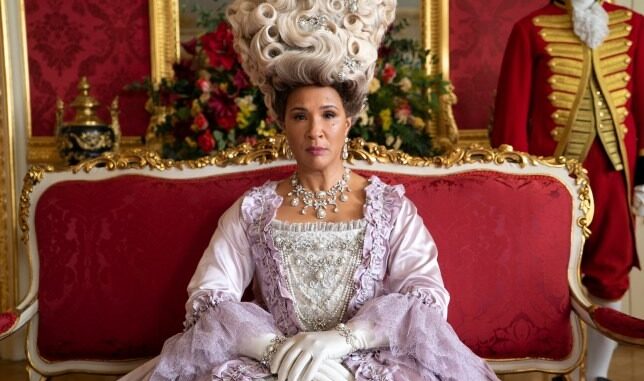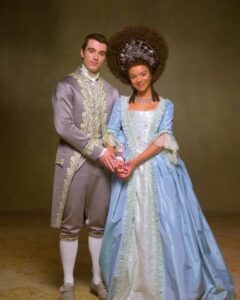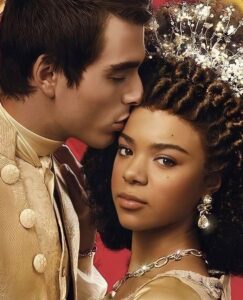
“Perhaps. Great love can make miracles”: Queen Charlotte: A Bridgerton Story
In the Bridgerton universe, Queen Charlotte is the “embodiment of monarchy.” With her withering glares, authoritarian outbursts and bold wigs, Queen Charlotte has become a beloved character in the Shondaland and Netflix series. Now, the time has come for her own prequel: Queen Charlotte: A Bridgerton Story.
Set in the 18th century, Queen Charlotte: A Bridgerton Story portrays the life of Queen Charlotte and her rise to power. Over the course of six mesmerizing episodes, the audience learns how Charlotte (India Amarteifio, Sex Education) came to sit on the British throne and how her marriage to King George III (Corey Mylchreest, The Sandman) became a groundbreaking love story.

In Netflix’s new spinoff there is much to discover about the Queen’s personality. As the title suggests, the series focuses on Charlotte’s origins, especially her turbulent marriage and how she learns to thrive in the palace and in society. “I wanted to explore how Charlotte came to be who she was,” explained Tom Verica, director of the production.
Instead of a classic linear narrative, the miniseries establishes two distinctly different timelines. It runs between the Queen’s past, when Charlotte first meets the young King of England, and the present era, which follows the events of the Bridgerton series. It is worth adding that the spin-off delves into three powerful women from the original series: Queen Charlotte evidently, Violet Bridgerton (Ruth Gemmell, Cliffs of Freedom), and Lady Danbury (Adjoa Andoh, Fractured).
In the first timeline, we meet our protagonist, a beautiful 17-year-old German princess, headstrong and of mixed racial heritage, who has been promised in marriage to King George III. Although at first the alliance between the youngsters is purely politically motivated, the couple eventually – and not without difficulty – comes to enjoy a loving relationship.
The central conflict of the fiction unfolds as King George’s mental illness causes deep misunderstandings and tensions between the Queen and her husband. The series painstakingly chronicles the silent battle waged by the young King of England and his harrowing efforts to overcome his condition.
Another important theme in the program is race and racial integration. Because Charlotte represents the first Queen of color to join the British royal family, the young woman also has to face the social implications of her rise to power.
In the prequel’s “current” timeline, we follow the flamboyant monarch as she enters middle age. The Queen rules mostly alone, while her husband’s mental health continues to decline. This timeline focuses primarily on Queen Charlotte’s (Golda Rosheuvel, Dune) children and the hereditary crisis over the crown. It so happens that the sovereign’s wayward descendants have innumerable illegitimate heirs, posing a major complication for the monarchy.
Distraught and impatient, the Queen decides to pair her sons and daughters with respectable peers and pressures them to have a legitimate heir to the throne. As expected, the Queen spares no trickery and goes to great lengths to secure the line of succession; the alternation between the two timelines helps to show the narrative arc and the transformation of the protagonist.
It is noteworthy that in both periods, Queen Charlotte: A Bridgerton Story explores the tension between romantic love and the duty of a member of royalty. At its core, the show raises serious questions such as: What is the true meaning of love? What is the true meaning of duty? Must one be sacrificed for the other?
The fiction explains how the marriage of young Queen Charlotte to King George III triggers both a great love story and a social change for its time. Through the marriage, the program ends up touching on issues related to race, mental health, sacrifice, women’s empowerment, desire and, finally, the meaning of the romantic couple over time.
The Bridgerton Label
Overall, the show maintains the stylistic traits of the main series, from the corsets, the slow-burning romance, the dreamy dances, the classic versions of contemporary songs, the cadent chemistry, to Lady Whistledown’s voiceover. It’s wonderful to know that Bridgerton is back and proving as vibrant as ever.
Undeniably one of the highlights of the program is the writing. On the one hand, the argument is compelling and the narrative twists and turns make you curious. On the other hand, the dialogues flow with naturalness and aplomb and move the series forward in just the right measure. Like every other plot in the Bridgerton universe, the story is filled with stinging romantic statements and insightful one-liners.
The true story of Queen Charlotte
Although the new Netflix spinoff announces in the first moments that the series “is not a history lesson,” the truth is that it is loosely based on the second longest serving consort in British history. In this regard, those responsible for the show have explained that “it is fiction inspired by real events.”

Queen Charlotte: A Bridgerton Story refers to the real life of Princess Sophia Charlotte of Mecklenberg-Strelitz (Germany), who married King George III in 1761. Historical records indicate that the couple enjoyed an affectionate and fruitful relationship for 25 years. In that time period, the marriage was perceived as a great victory as the betrothal produced many children. While the couple tried to stay together as long as possible, the King’s deteriorating mental health forced them to live apart.
Although the program is not an accurate depiction of actual events, the miniseries largely addresses these facts. However, the prequel takes all sorts of creative liberties when it portrays Charlotte as a woman of color whose marriage opened the door to social equality.
Show creator Shonda Rhimes has said that her vision for Queen Charlotte was driven by a very personal desire to offer audiences new images of autonomous, courageous and powerful women of color on screen.
Verdict
“Dearest readers” – in the words of Lady Whistledown – the Bridgerton spin-off series gives us an intimate look at the woman under the crown and, truth be told, every second is worth it.
Queen Charlotte: A Bridgerton Story is not a perfect fairy tale. Unlike the main Bridgerton series, this prequel does not have a happy ending. The romantic bond between Charlotte and George is by far the most tragic, yet most captivating and satisfying courtship we’ve seen in the Bridgerton universe thus far.
Queen Charlotte arouses intense emotions and throbs in the memory, refusing to be forgotten. Watching it, we can relive the impact of successful romantic productions such as The Notebook or A Walk to Remember.
Although Shondaland and Netflix’s fiction demonstrates that the course of true love is never easy, the story at all times invites us to hold on to Reynolds’ words: “Perhaps. Great love can make miracles.”
